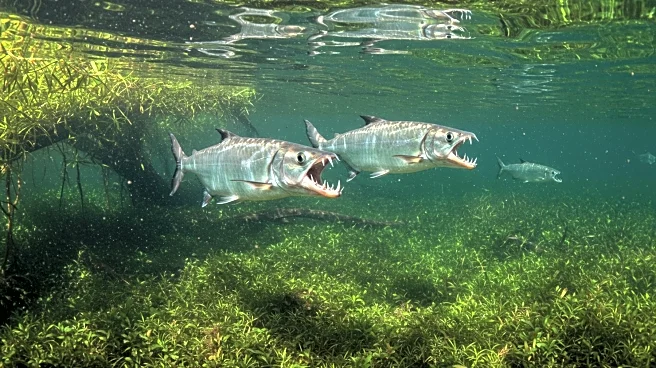What is the story about?
What's Happening?
A new species of Amazonian fish, Myloplus sauron, has been discovered by an international team led by Dr. Rupert Collins from the Natural History Museum in London. This fish, belonging to the Serrasalmidae family, is a herbivore with human-like molars, contrasting the razor-sharp teeth of its infamous piranha relatives. Myloplus sauron is distinct from other pacus, which are primarily plant eaters, and uses its unique teeth to consume fruits and seeds. The species was identified through DNA barcoding and detailed scale counts, distinguishing it from similar pacus previously grouped with M. schomburgkii. The fish is found exclusively in the Xingu River Basin in Brazil, known for its clear waters and unique biodiversity.
Why It's Important?
The discovery of Myloplus sauron is significant for biodiversity conservation in the Amazon. Naming the species after a cultural icon like the 'Eye of Sauron' helps raise public awareness about the unique ecosystem of the Xingu River, which faces threats from hydroelectric dams and mining activities. Understanding the distinct species within the Amazon is crucial for conservation efforts, as it allows for better assessment of population health and environmental pressures. The use of DNA barcoding in identifying new species highlights the importance of genetic tools in preserving biodiversity and guiding future research expeditions.
What's Next?
The identification of Myloplus sauron as a separate species underscores the need for continued research and conservation efforts in the Amazon Basin. While currently listed as 'Least Concern,' the species' habitat is vulnerable to environmental changes caused by human activities. Researchers advocate for early recognition and protection of such species to prevent potential declines. The study also emphasizes the role of DNA barcoding in uncovering hidden lineages, which can inform conservation strategies and enhance understanding of Amazonian biodiversity.
Beyond the Headlines
The discovery of Myloplus sauron sheds light on the broader implications of species identification in conservation. Accurate species cataloging is essential for monitoring ecosystem health and implementing effective conservation policies. The unique adaptations of Myloplus sauron, such as its human-like teeth, illustrate the diverse evolutionary strategies within the Amazon, highlighting the complexity and richness of this ecosystem. Protecting such species is not only crucial for maintaining biodiversity but also for preserving the cultural and ecological heritage of the region.
AI Generated Content
Do you find this article useful?













